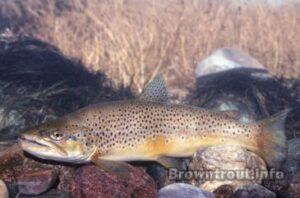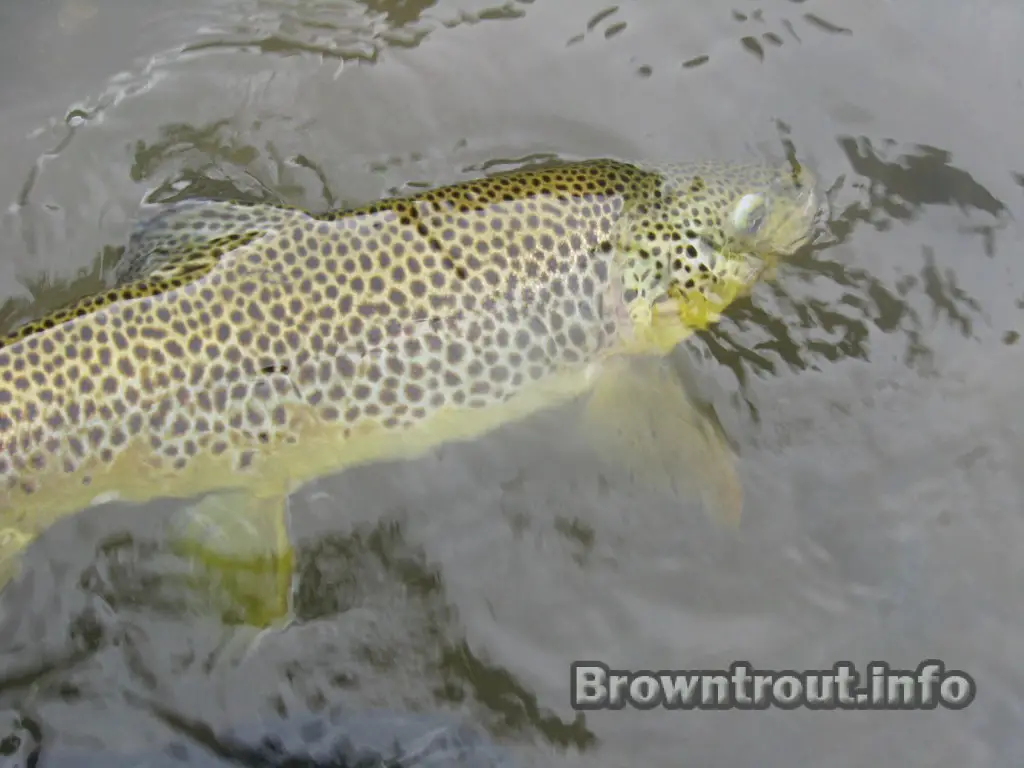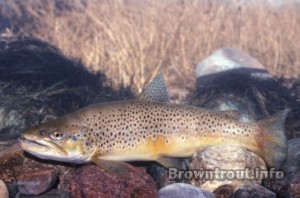This post was last updated on December 3rd, 2022 at 06:55 pm
The Brown trout has a few various scientific names, including Salmo trutta morpha trutta, Salmo trutta morpha fario and Salmo trutta morpha lacustris. “Morph or morpha” means that there are more than one phenotype in the populations of a particular brown trout sub species. In other words, these were at one time different populations of fish in separate areas that have evolved differently.
Brown Trout Subspecies – The Different Types of Brown Trout

It would also seem that within these populations exist even more variation. You will notice that trout in one particular river will often times look much different than the brown trout in another river. These are usually minor differences such as the size of the spots, the density of the spots, or the overall shade of the trout.
Many rivers seem to have fish that are much darker than others and often with even differences in the size and shape of the fins. Also there are many brown trout variances in the different areas of Europe. The fish from Scotland or Ireland certainly look different than the browns in Germany, yet they are technically considered the same species.
Many differences in these fish will come from the food sources that they use however. You can conclude safely that a trout that follows schools of bait fish around will grow much thicker and faster than a trout that regularly feeds on small insects. There are clearly different genes in many of these fish will make them prefer one type of food over another, this will in turn cause the fish to show many of the noticeable differences from one watershed to another.
I have also heard that fish that eat a lot of salmon flies will actually turn more orange colored. There are cases of humans turning orange tinted after eating a lot of carrots, so it would make sense that fish eating half their body weight in orange salmon flies could possibly alter their color.
It could be that fish that prefer to feed specifically on a particular food or insect could theoretically alter their coloration dramatically. I haven’t found evidence of this but it seem logical. I have noticed it in cutthroats more so than browns, but since the salmon flies are most abundant in the spring shortly after the cutthroat spawn it could just be spawning coloration.
Here’s a really good article I found about fly fishing for brown trout that you may find interesting.
Brown Trout Scientific Names
Brown Trout Subspecies #1 & 2: Salmo trutta morpha fario and Salmo trutta morpha lacustris
 This subspecies of brown trout is the local brown trout that spend their lives as residents of rivers and streams. They never go into lakes or the ocean in their lives, they are only found in fresh water unlike others. They tend to not be as large as trout that frequent lakes and larger water, because their available food sources are not as great.
This subspecies of brown trout is the local brown trout that spend their lives as residents of rivers and streams. They never go into lakes or the ocean in their lives, they are only found in fresh water unlike others. They tend to not be as large as trout that frequent lakes and larger water, because their available food sources are not as great.
Brown Trout Subspecies #3: Salmo trutta morpha trutta
This sub species is the sea run version of the brown trout. This species will spend most of their lives in the ocean and will migrate to fresh water in the fall to spawn.
Brown Trout Subspecies #4: SeeForrellen strain brown trout?
The seeforellen is somewhat confusing. Frankly I don’t think this is an actual species. It is often referred to as a larger species of brown trout–a fish with no red spots and very little coloration other than loose black spots. The name “SeeForellen” translates from english to german as lake trout. I am not sure what people are talking about using the term seeforellen as an identifier for a sub species of brown trout.
Think about it that for a moment. It would make the name of this trout “lake trout brown trout.” That sounds kind of weird, does it not?
You can see here that the “Wisconsin Department of Natural Resources stocked about 60,000 Seeforellen-strain brown trout in Lake Superior waters near Superior.” In this article from the Duluth news, they refer to the planting of these trout as a separate strain of trout. However I conclude that these fish are the Salmo trutta morpha trutta strain, or simply the anadromous (sea run) brown trout that spend most of its life in salt water.
As described these fish have bland silvery coloration consistent with that of trout in lakes and ocean run fish, but they attain a much larger size than the browns you’ll find in freshwater bodies of water.
Brown Trout Sub Species Summary
All in all, there are severaal different species of brown trout. Depending on where they live, there are usually some variances between the different subspecies. Hopefully this article clears up any questions you have about some of the different types of brown trout and what their scientific names are.

